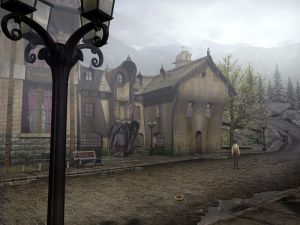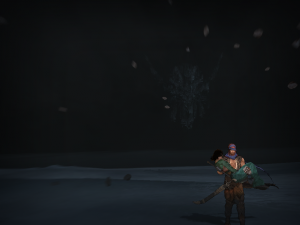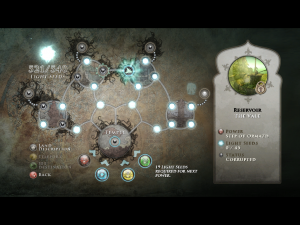For our next game, we have Prince of Persia, which unfortunately doesn’t have a subtitle to distinguish it from Prince of Persia. Prince of Persia at least had the excuse of being the only game titled Prince of Persia when it was released, but I’m not playing that one, I’m playing Prince of Persia, the 2008 game with a new “prince” (apparently a thief, although I suspect he’s just pretending and incognito) assisting Elika, a young magician-princess, in keeping Ahriman, the god of darkness, from escaping his prison. I won’t call this a “reboot”, because I think it’s pretty well-established, in “expanded universe” materials if nowhere else, that PoP continuity contains multiple different Princes echoing each others’ stories at various points in history. This is just one of the ones we haven’t seen before.
I have quite a lot to say about the gameplay, but for this post, I’ll just share some early impressions.
The graphical style makes a strong first impression, somehow looking very illustration-like. It’s not cel-shaded, but there’s some similar simplification going on, or maybe it’s just the thin black outlines on the characters that make it seem that way. It reminds me of what little I’ve seen of Street Fighter IV. Still, as usual, it doesn’t take long to get used to it and not notice it any more. Elika’s magical effects, on the other hand, turn her outline and shadows, and sometimes those of Prince as well, into pale blue, and that remains a striking effect when it happens, presumably because it’s not in front of your eyes all the time.
My second strong impression is dismay at the characters’ wardrobe. It’s not nearly as direly sexualized as in Warrior Within, but there’s still a strong “who in their right mind would wear that in public” vibe. It isn’t that they show a lot of skin — both the Prince and Farah wear more revealing outfits in The Sands of Time, but garments in this PoP08 expose skin strategically. The prince wears an impractical-looking muscle shirt that’s cut to show off his slab-like pectoral and abdominal muscles, and yet manages to give the impression that he has no nipples. Elika sports a tattered top that leaves weird portions of her hips exposed and was probably intended to go with some kind of high-waisted skirt instead of the trousers she’s got on. (Those trousers seem fairly practical, mind you, especially in contrast to everything else ever worn by any woman in a Prince of Persia game.) To expand on the contrast: in The Sands of Time, Farah managed to be dignified even in her slave outfit, while the Prince was the hapless victim of gradual wardrobe loss, a symbol of his lack of control over the catastrophe that he himself helped to cause. That was their relationship in a nutshell. PoP08 turns this backward, giving the female lead a torn and ill-fitting outfit that suggests victimhood, and pairing her with a tall, muscular man who looks like he’s dressed to go cruising for chicks.
In fact, Elika’s weakness is a major plot point. Use of magic sometimes drains her to the point where she collapses onto the floor, or into the Prince’s arms. (The Prince manhandles her quite a lot, considering that they only just met.) And yet, whenever the player makes a mistake and jumps off a ledge or something, Elika uses her magic to instantly rescue him, regardless of the circumstances. Even if she’s bound up in a writhing cocoon of magical darkness and awaiting rescue, which is something that happens more than once over the course of the game, she finds a way to break out of it for just long enough to save the Prince, and then immediately becomes bound and helpless again. I suppose you could argue that this shows that the relationship between Elika and the Prince is really one of mutuality, that each of them relies on the other, but it feels more like the Prince’s needs come first, that he somehow has the right to expect a woman who’s suffering from fainting spells to run around making sure that he never has to suffer the consequences of his actions.
Am I being unfair? Perhaps. I have to admit that I simply find this incarnation of the Prince irritating. His type is what I think of as the Brendan Fraser role, all smug and cocksure, with a smirk in his voice. He keeps telling Elika that she ought to get out and live real life among ordinary people, which is not so much a piece of advice as an aggressive act of reverse-elitism, a way for him to act superior and assume authority while at the same time accusing her of the superior attitudes. And in contrast to the Prince’s arrogance in The Sands of Time, which was flaw that humanized the character and made him more sympathetic, it seems like in PoP08 the writer, or possibly just the voice actor, doesn’t even think he’s being arrogant. He’s just trying to be the common-sense voice that the audience agrees with. If the Prince and Farah in TSoT bickered like Tracy and Hepburn, the banter in PoP08 comes off more like the arguments between Spock and McCoy, and has about as much romantic tension. Fortunately, most of the dialogue is optional, and only comes up if you choose to press the “talk” button.
I had to look this up, but a growing suspicion of mine turned out to be correct: the voice actor for the Prince is none other than Nolan North, best known as the voice of Nathan Drake in the Uncharted series. I haven’t played any of the Uncharted games, and certainly didn’t recognize the voice. I just guessed this on the basis of the complaints I’ve heard about Drake.
Anyway, despite all that, I am quite enjoying the actual game. When my mind is on wall-running and leaping across chasms, I don’t much care about what my avatar is wearing, or what he sounds like. And it’s rather compelling, with a strong “one more level and then I’ll stop” factor, possibly assisted by the way that Elika’s automatic rescues keep you away from any kind of “game over” screen or save/load menu.
I recall that these auto-rescues were controversial when the game was first released, and that some people complained that it caused the game to lose something — a sense of danger or whatever. I was skeptical about this; it seemed to me that it was just expediting the die/restore or checkpoint cycle, and thus not really changing the interactivity in any significant way. Well, I don’t quite know how to justify this, but in practice, it honestly does feel different, like your failures are less significant than they should be. Perhaps it’s the fact that it’s happening within the context of the game’s fiction, and thus makes you aware of the cheatingness of infinite take-backs in a way that you don’t notice when it’s at the system level. Perhaps it’s that the game is robbing you of even the possibility of doing things wrong, and thereby reducing the sense of agency. Regardless, it only feels this way for a while. Just like the graphics, I got used to it pretty quickly.
 Syberia (not to be confused with the cheesy 1994 FMV game Cyberia) is an atmospheric point-and-click adventure by Benoit Sokal, a Belgian comic book artist and game designer. What is it with Belgian comics and adventure games? Well, in this particular case, I think it has a lot to do with living in the shadow of Hergé. Like the adventures of Tintin, Syberia is a story of traveling to distant lands where everything and everyone is a little odd, rendered in a style that’s fanciful and caricatured, but at the same time oddly restrained about it. This is one of those adventure games with pre-rendered backgrounds under 3D characters and other animated elements. The art is gorgeous, very old-world picturesque with intense clarity of detail and a very pleasing distance haze.
Syberia (not to be confused with the cheesy 1994 FMV game Cyberia) is an atmospheric point-and-click adventure by Benoit Sokal, a Belgian comic book artist and game designer. What is it with Belgian comics and adventure games? Well, in this particular case, I think it has a lot to do with living in the shadow of Hergé. Like the adventures of Tintin, Syberia is a story of traveling to distant lands where everything and everyone is a little odd, rendered in a style that’s fanciful and caricatured, but at the same time oddly restrained about it. This is one of those adventure games with pre-rendered backgrounds under 3D characters and other animated elements. The art is gorgeous, very old-world picturesque with intense clarity of detail and a very pleasing distance haze.  Comments(1)
Comments(1)
